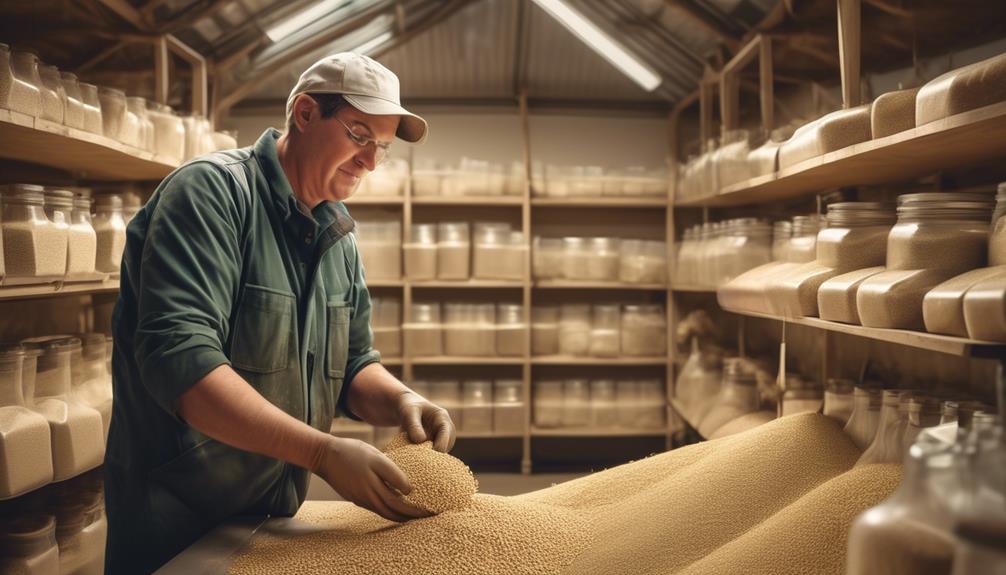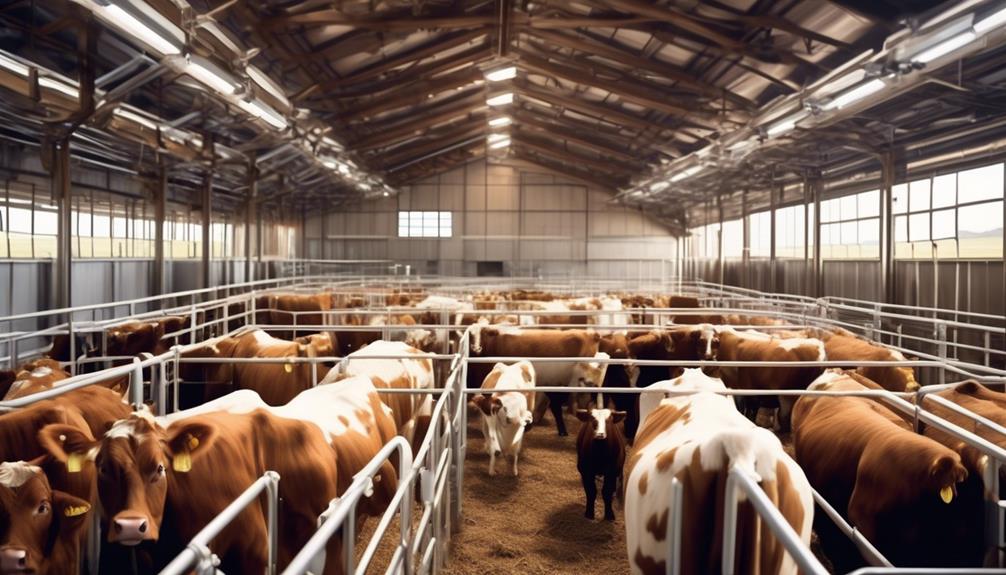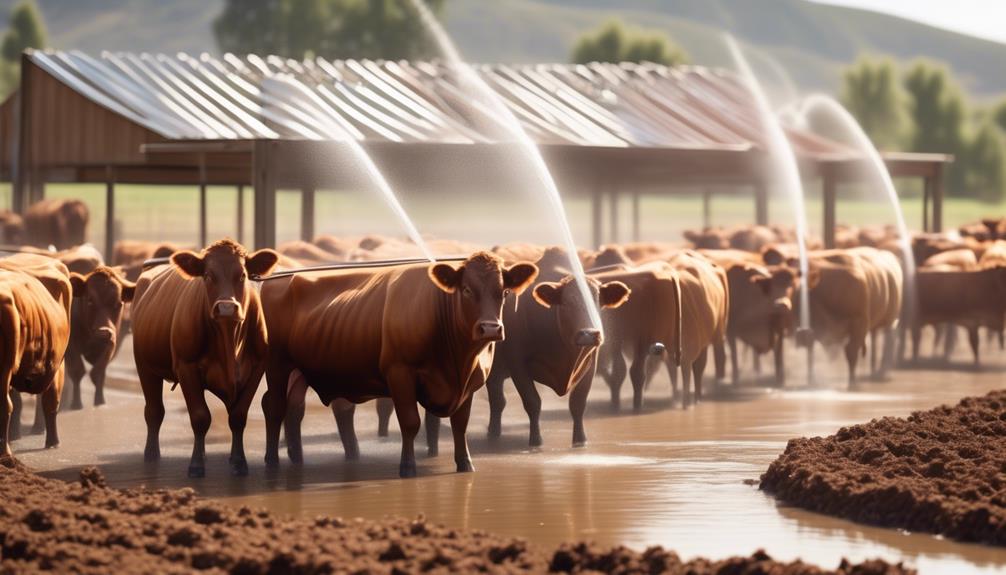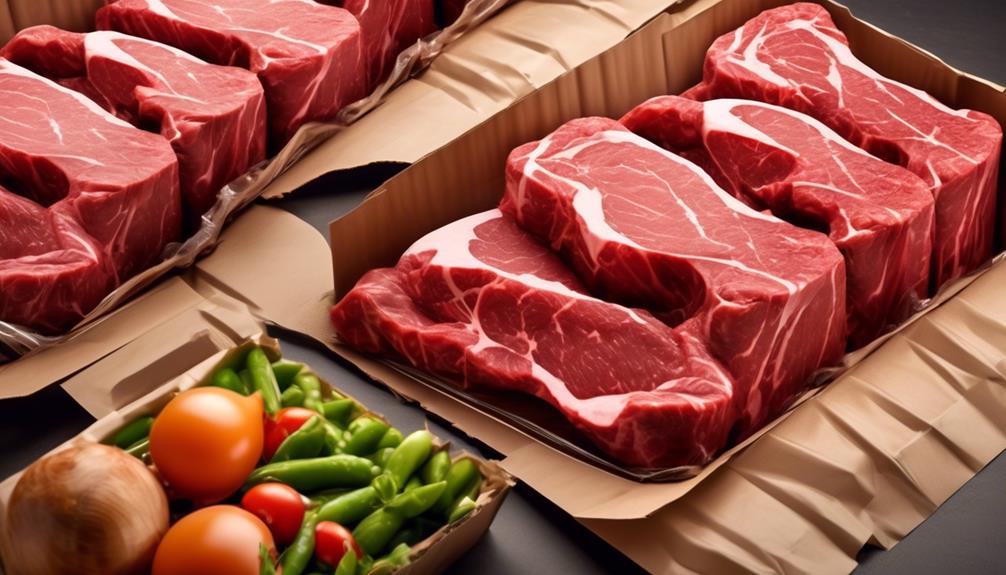12 Ways to Reduce Waste in Beef Production
You may not realize that beef production is a major contributor to environmental waste and inefficiency. However, there are numerous ways to reduce waste in this industry that not only benefit the environment but also improve the bottom line for producers.
By implementing some key strategies, you can significantly minimize waste and maximize resources in beef production. From efficient feed management to innovative by-product utilization, these 12 methods offer practical and effective ways to enhance sustainability in beef production.
Efficient Feed Management

To minimize waste in beef production, efficient feed management is crucial for optimizing resources and reducing environmental impact. Feed optimization involves carefully planning the type and amount of feed given to cattle, ensuring that they receive the necessary nutrients without excessive waste. By closely monitoring their nutritional needs and adjusting the feed accordingly, you can minimize overfeeding and reduce the amount of unused feed that ultimately becomes waste.
In addition, waste reduction can be achieved through strategic feeding schedules. Rather than providing large amounts of feed at irregular intervals, implementing a consistent feeding schedule can help ensure that cattle consume the allotted feed without leaving excess behind. This approach not only minimizes waste but also promotes efficient digestion and nutrient absorption in the animals.
Furthermore, proper storage and handling of feed can significantly contribute to waste reduction. Storing feed in a manner that prevents spoilage and minimizing exposure to pests and environmental elements can help maintain its quality and prevent unnecessary waste. Additionally, employing efficient feeding methods such as using feed bunks and feeders designed to minimize spillage can further reduce feed wastage.
Sustainable Grazing Practices
Implement sustainable grazing practices to improve land utilization and reduce environmental impact in beef production. Sustainable grazing practices not only benefit the environment but also contribute to the overall health and productivity of the herd. Here are some key strategies to consider:
- Rotational Grazing
- Rotational grazing involves dividing pastures into smaller paddocks and rotating livestock through these areas. This approach allows for rest periods, which promotes regrowth and prevents overgrazing. By moving cattle to fresh forage regularly, rotational grazing maximizes the utilization of available pasture and minimizes waste.
- Pasture Management for Erosion Control and Soil Health
- Effective pasture management techniques, such as maintaining proper ground cover and implementing erosion control measures, play a crucial role in preserving soil health. Well-managed pastures help to reduce soil erosion, improve water infiltration, and promote the retention of organic matter. These practices contribute to the overall sustainability of grazing operations and support long-term land productivity.
Precision Health and Welfare Management

When managing the health and welfare of your beef herd, precision techniques can optimize productivity and minimize waste. Implementing data-driven monitoring systems allows you to track individual animal well-being and identify potential health issues early on. By utilizing this approach, you can intervene promptly, reducing the risk of productivity losses due to illness or injury.
Data-driven monitoring involves collecting and analyzing various data points, such as feed intake, weight gain, activity levels, and even physiological indicators like body temperature and rumination patterns. These insights enable you to make informed decisions about the health and welfare of your herd, allowing for proactive measures to maintain animal well-being.
Furthermore, precision health and welfare management also includes the use of advanced technology, such as wearable devices and remote sensors, to continuously monitor your beef herd. These tools provide real-time information, allowing you to respond swiftly to any anomalies and ensure that your animals receive the care they need promptly. By addressing potential health issues early and providing appropriate interventions, you can minimize the risk of productivity losses and reduce waste in beef production.
Optimal Manure and Nutrient Management
Maximizing the utilization of nutrients from manure in beef production is essential for sustainable and efficient farming practices. Proper manure management not only reduces waste but also plays a crucial role in maintaining soil fertility and minimizing environmental impact.
To optimize manure and nutrient management on your beef farm, consider the following:
- Manure Composting
- Encourage the decomposition of manure through composting to create a valuable organic fertilizer. This process not only reduces the volume of manure but also kills pathogens and weed seeds, resulting in a safer and more potent soil amendment for your crops.
- Utilize a well-designed composting system to efficiently manage the process, ensuring proper aeration and moisture levels to facilitate decomposition and minimize odors.
- Nutrient Recycling
- Implement practices such as rotational grazing to allow for natural recycling of nutrients. By moving cattle to different grazing areas, you can prevent overloading the soil with manure in one location, promoting more even distribution of nutrients and healthier pasture growth.
- Consider incorporating cover crops into your rotation to capture and utilize excess nutrients from manure, reducing the risk of nutrient runoff and leaching while improving soil health.
Effective Water Usage Strategies

Encouraging efficient water usage practices is crucial for optimizing beef production and minimizing waste in farming operations. Implementing advanced irrigation techniques is a key aspect of water conservation in beef production. Drip irrigation, for example, delivers water directly to the roots of plants, reducing water usage and minimizing evaporation. Additionally, utilizing soil moisture sensors can help farmers to precisely monitor the water needs of their crops, preventing over-irrigation and water wastage.
Water recycling is another vital strategy for effective water usage in beef production. Implementing systems for capturing and treating runoff water from feedlots can provide a sustainable source of water for other farm operations. Furthermore, integrating drought management practices such as rainwater harvesting and storage can help mitigate the impact of water scarcity during dry periods.
In addition to these techniques, adopting precision irrigation technologies can significantly improve water efficiency in beef production. These technologies utilize real-time data and weather forecasts to adjust irrigation schedules, ensuring that water is applied only when and where it's needed.
Streamlined Slaughter and Processing Techniques
To further optimize beef production and minimize waste, enhancing the efficiency of slaughter and processing techniques is essential. Streamlining these processes can significantly contribute to waste reduction and resource optimization. Here are some key points to consider:
- Improved Equipment
- Upgrading to state-of-the-art machinery and tools can greatly improve the speed and precision of the slaughtering and processing stages. Look for equipment that can handle a higher volume of beef with minimal waste, such as advanced cutting and deboning machinery.
- Implementing modern refrigeration and storage systems can also help preserve the quality of beef products, reducing spoilage and waste.
- Automation Technology
- Embracing automation in slaughter and processing can streamline operations, leading to higher efficiency and reduced labor costs. Automated systems can precisely handle tasks such as carcass movement, cutting, and packaging, minimizing human error and waste.
- Utilizing advanced tracking and monitoring systems can enhance traceability and quality control, ensuring that resources are used optimally throughout the entire production process.
Smart Packaging and Distribution Solutions

Consider implementing innovative packaging and distribution solutions to minimize waste and optimize resource utilization in beef production.
Sustainable packaging plays a crucial role in reducing waste throughout the supply chain. By using eco-friendly materials and designing packaging that extends the shelf life of beef products, you can significantly decrease the amount of food that goes to waste. Look for packaging options that aren't only durable but also biodegradable or recyclable to minimize environmental impact.
Transportation efficiency is another key aspect to focus on. Streamlining distribution processes and optimizing transportation routes can lead to significant reductions in fuel consumption and greenhouse gas emissions. Utilizing technologies such as route optimization software and investing in more fuel-efficient vehicles can help minimize the environmental footprint of beef distribution. Additionally, exploring alternative transportation methods, such as rail or sea freight, for long-distance shipments can further improve efficiency and reduce carbon emissions.
It's also essential to consider the use of reusable packaging and pallets to minimize waste and promote sustainability in distribution. Implementing a closed-loop system for packaging and pallets can help reduce the amount of single-use materials being discarded after each shipment, ultimately contributing to a more sustainable beef production process.
Innovative By-Product Utilization
Optimizing beef production not only involves smart packaging and distribution solutions but also requires exploring innovative by-product utilization to minimize waste and promote sustainability.
When it comes to innovative by-product utilization in beef production, there are several key strategies that can be employed to reduce waste and maximize the use of every part of the animal. Here are some ways in which novel ingredient utilization can be leveraged to achieve this goal:
- Value-Added Products: Transforming by-products such as bones, trimmings, and organs into value-added products like pet food, bone meal, and organ meats for human consumption can significantly reduce waste while creating additional revenue streams for producers.
- Utilizing Advanced Processing Techniques: Implementing advanced processing techniques such as freeze-drying, high-pressure processing, and enzymatic hydrolysis can help extract valuable nutrients and flavors from by-products, enabling their use in a wide range of consumer products.
Furthermore, waste reduction can also be achieved by collaborating with research institutions and food technology companies to develop innovative methods for utilizing beef by-products effectively. By exploring novel ingredient utilization and implementing waste reduction strategies, the beef industry can move towards a more sustainable and efficient production model.
Frequently Asked Questions
How Can Beef Producers Work With Local Communities to Reduce Waste in Beef Production?
You can work with local communities to reduce waste in beef production by fostering local partnerships, engaging with the community, and implementing sustainable supply chain practices. By prioritizing waste management, you can create a more sustainable beef production process.
What Role Do Government Regulations Play in Promoting Waste Reduction in Beef Production?
Government regulations play a crucial role in promoting waste reduction in beef production. By setting standards and enforcing compliance, they can drive industry collaboration and innovation to minimize waste and improve sustainability in beef production.
Are There Any Emerging Technologies or Innovations That Could Help Reduce Waste in Beef Production?
You can explore emerging technologies and innovative solutions to reduce waste in beef production. New methods like precision farming, waste-to-energy systems, and biodegradable packaging offer promising ways to minimize environmental impact and enhance sustainability.
How Can Consumers Support Efforts to Reduce Waste in Beef Production Through Their Purchasing Decisions?
You can influence beef production waste by making sustainable choices. Consider buying locally sourced, organic, or grass-fed beef. Support companies that prioritize waste reduction and sustainable practices. Your purchasing decisions have a significant impact.
What Are the Long-Term Environmental Benefits of Implementing Waste Reduction Strategies in Beef Production?
By implementing waste reduction strategies in beef production, you can help create long-term environmental benefits. Sustainable practices reduce waste and minimize environmental impact, leading to economic benefits and long-term solutions for a healthier planet.
Conclusion
In conclusion, there are numerous ways to reduce waste in beef production.
Efficient feed management and innovative by-product utilization are two strategies that can be implemented.
By implementing these strategies, you can make a significant impact on the sustainability of beef production and contribute to a healthier environment.
With a focus on sustainable practices and smart management, you can play a crucial role in reducing waste and ensuring the long-term viability of beef production.
